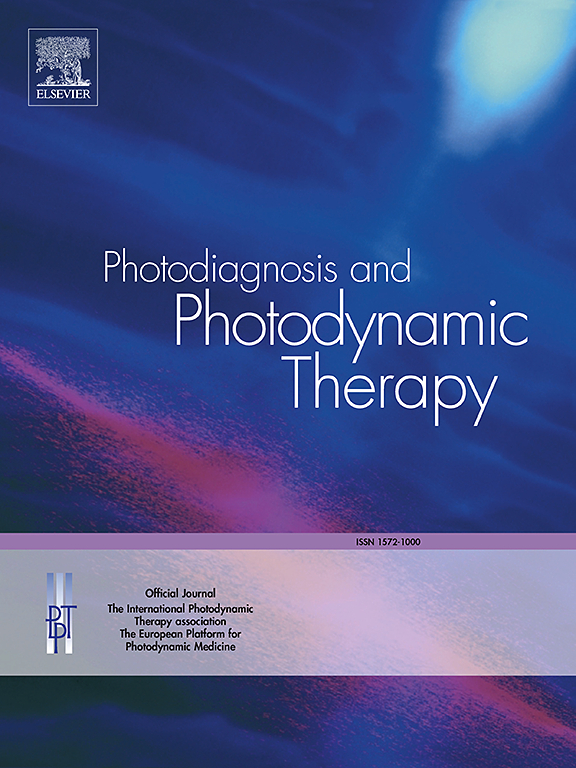Supramolecular gels for antimicrobial photodynamic therapy against E. coli and S. aureus
IF 3.1
3区 医学
Q2 ONCOLOGY
引用次数: 0
Abstract
Singlet oxygen (SO) reacts with organic molecules, for example in degrading environmental contaminants and causing toxicity to cells in photodynamic therapy (PDT). The relevance of SO in the environmental and biomedical domains has fuelled research towards improved methodologies for its efficient generation. In this paper, we report the use of a bis-imidazolium-based amphiphile that forms supramolecular gels in water-ethanol mixtures encapsulating SO generating chromophores. The gels comprise twisted fibres that incorporate one of four different porphyrins: 5,10,15,20-tetrakis(N-methyl-4-pyridinium)porphyrin tetraiodide (TPPP), 5,10,15,20-tetrakis(4-carboxyphenyl)porphyrin (TCPP), 5,10,15,20-tetrakis(3-hydroxyphenyl)porphyrin (TPP-3OH) and 5,10,15,20-tetrakis(4-hydroxyphenyl)porphyrin (TPP-4OH). Rheological measurements confirmed viscoelastic properties characteristic of these types of supramolecular gels, suggesting their potential as effective local PDT delivery systems. Enhanced SO generation within the hydrogel matrix compared to the solution of the chromophores was observed in suspension in a spectrophotometer using uric acid as the molecular probe. The SO generation was also shown through antimicrobial PDT (aPDT) studies. The TPPP-containing gel showed the highest reduction in the colony forming unit (CFU) count, which is 94% against E. coli and 100% against S. aureus. These results indicate that the porphyrin gels based on a gemini amphiphile with a high level of SO production are of significant interest and have a lot of potential use in aPDT.

用于抗菌光动力治疗大肠杆菌和金黄色葡萄球菌的超分子凝胶。
单线态氧(SO)与有机分子发生反应,例如在降解环境污染物和光动力疗法(PDT)中对细胞产生毒性。SO在环境和生物医学领域的相关性推动了对其有效产生的改进方法的研究。在本文中,我们报道了一种基于双咪唑的两亲性物质的使用,它在水-乙醇混合物中形成超分子凝胶,包封SO生成发色团。凝胶由扭曲纤维组成,其中含有四种不同卟啉中的一种:5,10,15,20-四(n -甲基-4-吡啶)四碘卟啉(TPPP), 5,10,15,20-四(4-羧基苯基)卟啉(TCPP), 5,10,15,20-四(3-羟基苯基)卟啉(TPP-3OH)和5,10,15,20-四(4-羟基苯基)卟啉(TPP-4OH)。流变学测量证实了这些类型的超分子凝胶的粘弹性特性,表明它们有潜力成为有效的局部PDT输送系统。用尿酸作为分子探针,在分光光度计中观察到水凝胶基质中与发色团溶液相比,SO的生成增强。抗菌PDT (aPDT)研究也显示了SO的产生。含有tppp的凝胶对大肠杆菌的菌落形成单位(CFU)计数的降低率最高,为94%,对金黄色葡萄球菌的降低率为100%。这些结果表明,基于高SO生成水平的gemini两亲化合物的卟啉凝胶具有重要的意义,并且在aPDT中具有很大的潜在用途。
本文章由计算机程序翻译,如有差异,请以英文原文为准。
求助全文
约1分钟内获得全文
求助全文
来源期刊

Photodiagnosis and Photodynamic Therapy
ONCOLOGY-
CiteScore
5.80
自引率
24.20%
发文量
509
审稿时长
50 days
期刊介绍:
Photodiagnosis and Photodynamic Therapy is an international journal for the dissemination of scientific knowledge and clinical developments of Photodiagnosis and Photodynamic Therapy in all medical specialties. The journal publishes original articles, review articles, case presentations, "how-to-do-it" articles, Letters to the Editor, short communications and relevant images with short descriptions. All submitted material is subject to a strict peer-review process.
 求助内容:
求助内容: 应助结果提醒方式:
应助结果提醒方式:


